2022届高考英语二轮专题复习:外刊精读(34)科学美国人 半梦半醒的中间状态,能让你创造力爆棚(1)学案(无答案)
文档属性
| 名称 | 2022届高考英语二轮专题复习:外刊精读(34)科学美国人 半梦半醒的中间状态,能让你创造力爆棚(1)学案(无答案) |
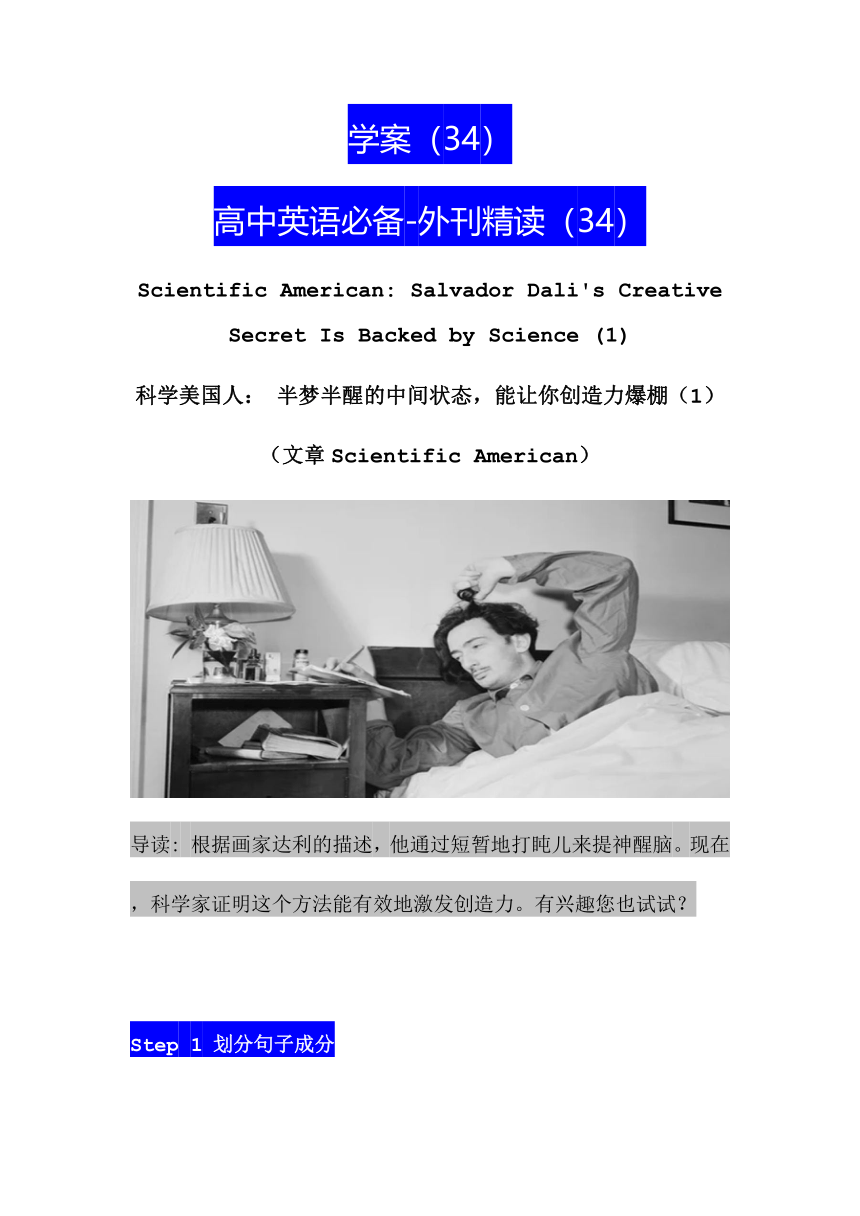
|
|
| 格式 | docx | ||
| 文件大小 | 500.4KB | ||
| 资源类型 | 教案 | ||
| 版本资源 | 通用版 | ||
| 科目 | 英语 | ||
| 更新时间 | 2022-02-22 22:43:58 | ||
图片预览

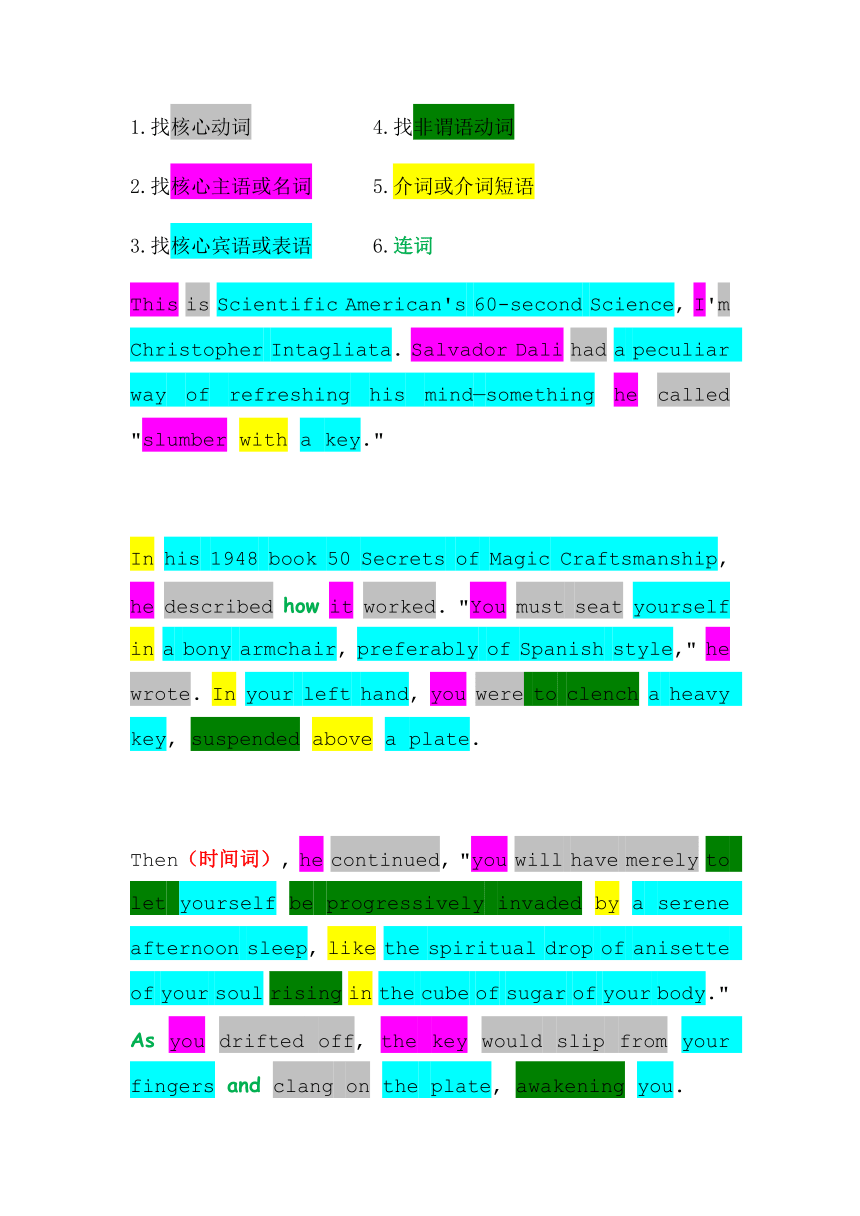
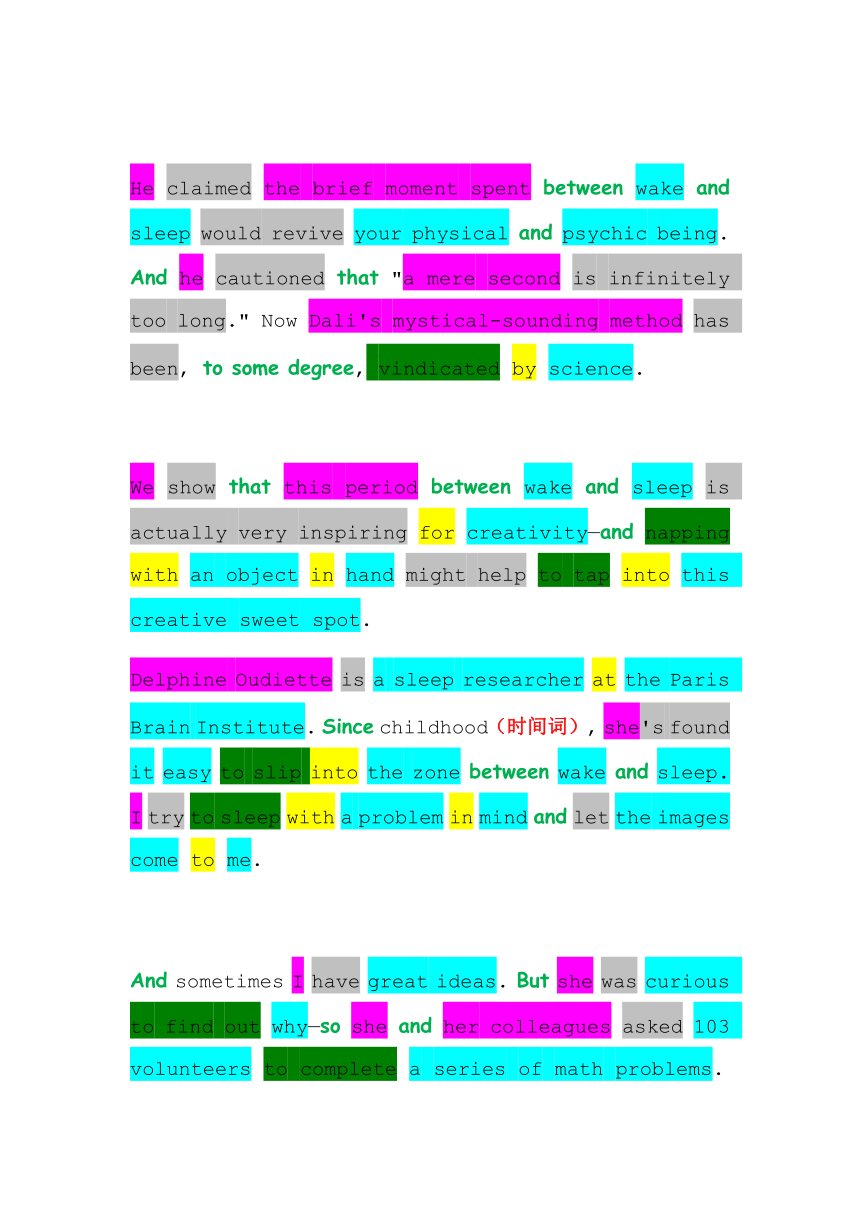
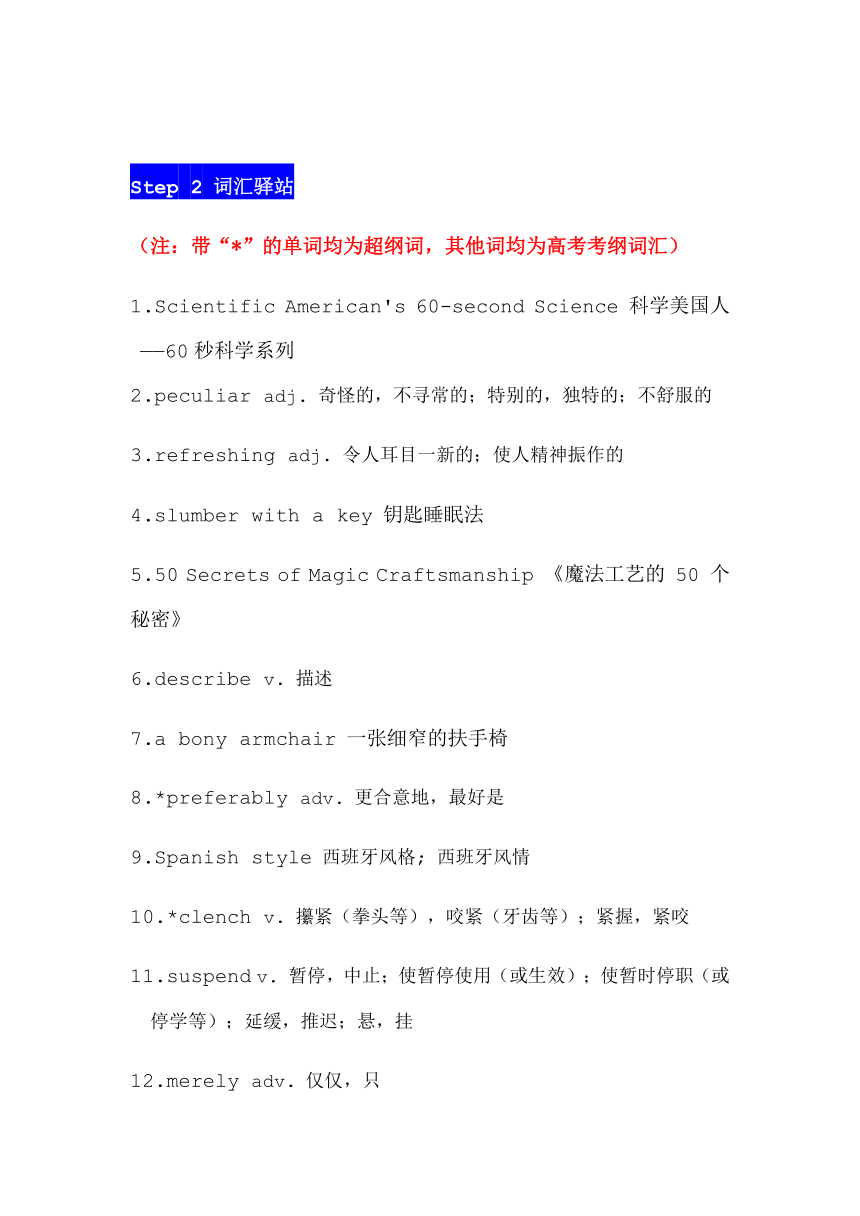
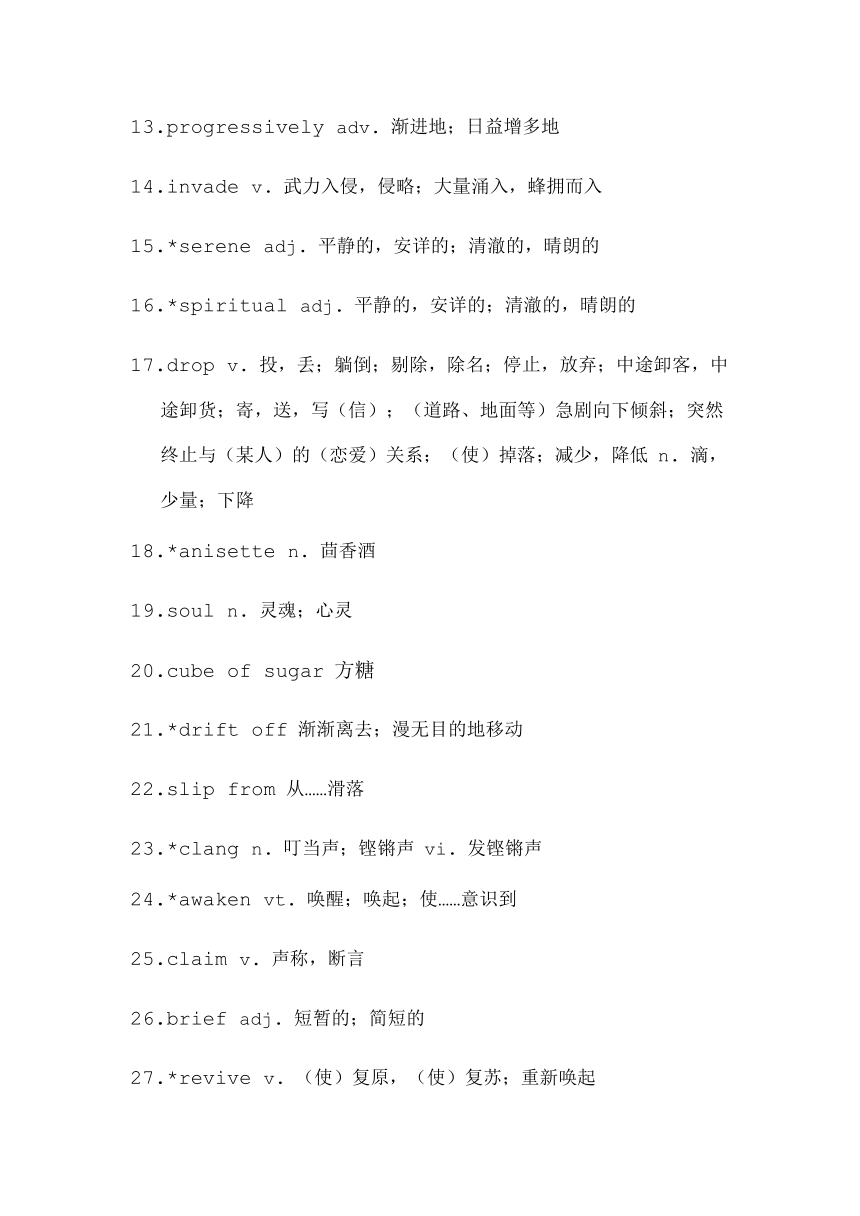
文档简介
学案(34)
高中英语必备-外刊精读(34)
Scientific American: Salvador Dali's Creative Secret Is Backed by Science (1)
科学美国人: 半梦半醒的中间状态,能让你创造力爆棚(1)
(文章Scientific American)
导读: 根据画家达利的描述,他通过短暂地打盹儿来提神醒脑。现在
,科学家证明这个方法能有效地激发创造力。有兴趣您也试试?
Step 1 划分句子成分
1.找核心动词 4.找非谓语动词
2.找核心主语或名词 5.介词或介词短语
3.找核心宾语或表语 6.连词
This is Scientific American's 60-second Science, I'm Christopher Intagliata. Salvador Dali had a peculiar way of refreshing his mind—something he called "slumber with a key."
In his 1948 book 50 Secrets of Magic Craftsmanship, he described how it worked. "You must seat yourself in a bony armchair, preferably of Spanish style," he wrote. In your left hand, you were to clench a heavy key, suspended above a plate.
Then(时间词), he continued, "you will have merely to let yourself be progressively invaded by a serene afternoon sleep, like the spiritual drop of anisette of your soul rising in the cube of sugar of your body." As you drifted off, the key would slip from your fingers and clang on the plate, awakening you.
He claimed the brief moment spent between wake and sleep would revive your physical and psychic being. And he cautioned that "a mere second is infinitely too long." Now Dali's mystical-sounding method has been, to some degree, vindicated by science.
We show that this period between wake and sleep is actually very inspiring for creativity—and napping with an object in hand might help to tap into this creative sweet spot.
Delphine Oudiette is a sleep researcher at the Paris Brain Institute. Since childhood(时间词), she's found it easy to slip into the zone between wake and sleep. I try to sleep with a problem in mind and let the images come to me.
And sometimes I have great ideas. But she was curious to find out why—so she and her colleagues asked 103 volunteers to complete a series of math problems.
Step 2 词汇驿站
(注:带“*”的单词均为超纲词,其他词均为高考考纲词汇)
1.Scientific American's 60-second Science 科学美国人——60秒科学系列
2.peculiar adj. 奇怪的,不寻常的;特别的,独特的;不舒服的
3.refreshing adj. 令人耳目一新的;使人精神振作的
4.slumber with a key 钥匙睡眠法
5.50 Secrets of Magic Craftsmanship 《魔法工艺的 50 个秘密》
6.describe v. 描述
7.a bony armchair 一张细窄的扶手椅
8.*preferably adv. 更合意地,最好是
9.Spanish style 西班牙风格; 西班牙风情
10.*clench v. 攥紧(拳头等),咬紧(牙齿等);紧握,紧咬
11.suspend v. 暂停,中止;使暂停使用(或生效);使暂时停职(或停学等);延缓,推迟;悬,挂
12.merely adv. 仅仅,只
13.progressively adv. 渐进地;日益增多地
14.invade v. 武力入侵,侵略;大量涌入,蜂拥而入
15.*serene adj. 平静的,安详的;清澈的,晴朗的
16.*spiritual adj. 平静的,安详的;清澈的,晴朗的
17.drop v. 投,丢;躺倒;剔除,除名;停止,放弃;中途卸客,中途卸货;寄,送,写(信);(道路、地面等)急剧向下倾斜;突然终止与(某人)的(恋爱)关系;(使)掉落;减少,降低 n. 滴,少量;下降
18.*anisette n. 茴香酒
19.soul n. 灵魂;心灵
20.cube of sugar 方糖
21.*drift off 渐渐离去;漫无目的地移动
22.slip from 从……滑落
23.*clang n. 叮当声;铿锵声 vi. 发铿锵声
24.*awaken vt. 唤醒;唤起;使……意识到
25.claim v. 声称,断言
26.brief adj. 短暂的;简短的
27.*revive v. (使)复原,(使)复苏;重新唤起
28.physical adj. 身体的,肉体的;物质的,有形的;外形的,外在的;物理的,物理学的
29.*psychic adj. 精神的;心灵的;灵魂的;超自然的 n. 灵媒;巫师
30.caution n. 小心,谨慎;提醒,告诫;(警察向犯轻罪的人发出的)警告
31.*infinitely adv. 无限地;极其
32.*mystical-sounding method 听起来神秘的方法
33.degree n. 度,度数;程度
34.*vindicate vt. 维护;证明……无辜;证明……正确
35.inspire v. 激励,鼓舞;赋予灵感
36.creativity n. 创造力,独创性
37.nap n. (尤指在白天)小睡,打盹
38.tap v. 轻拍,轻扣,轻敲;敲出节奏,打拍子 n. 水龙头
39.creative adj. 创造(性)的,创作的;有创造力的,有想象力的
40.spot n. 地点,场所;(人体的)部位,地方;有某种特质的部分;点,斑点;污点,污渍 v. 认出,发现
41.*Paris Brain Institute 巴黎大脑研究所
42.slip into 溜进;使滑入;匆忙穿上;大吃
43.zone n. (有某特色或作用的)地区,地带;(允许或禁止某种活动的)范围;(尤指有别于周围的)区域,部份;(规划的)区域
44.image n. 形象,印象;影像,映像,图像;比喻,意象;画像,塑像,雕像
45.curious adj. 好奇的,求知欲强的;稀奇的,不寻常的;爱挑剔的
46.colleague n. 同事,同僚
47.volunteer n. 志愿者,义务工作者 v. 自愿做,义务做 adj. 志愿(者)的
plete adj. 完全的,彻底的;全部的,完整的;完成的,结束的;技能全面的,技术娴熟的;向前传球成功的 v. 使完整,使完美;填写(表格);完成,结束
49.a series of 一系列的;一连串的
50.math problem 数学问题
Step 3 尽享原文
This is Scientific American's 60-second Science, I'm Christopher Intagliata. Salvador Dali had a peculiar way of refreshing his mind—something he called "slumber with a key."
In his 1948 book 50 Secrets of Magic Craftsmanship, he described how it worked. "You must seat yourself in a bony armchair, preferably of Spanish style," he wrote. In your left hand, you were to clench a heavy key, suspended above a plate.
Then, he continued, "you will have merely to let yourself be progressively invaded by a serene afternoon sleep, like the spiritual drop of anisette of your soul rising in the cube of sugar of your body." As you drifted off, the key would slip from your fingers and clang on the plate, awakening you.
He claimed the brief moment spent between wake and sleep would revive your physical and psychic being. And he cautioned that "a mere second is infinitely too long." Now Dali's mystical-sounding method has been, to some degree, vindicated by science.
We show that this period between wake and sleep is actually very inspiring for creativity—and napping with an object in hand might help to tap into this creative sweet spot.
Delphine Oudiette is a sleep researcher at the Paris Brain Institute. Since childhood, she's found it easy to slip into the zone between wake and sleep. I try to sleep with a problem in mind and let the images come to me.
And sometimes I have great ideas. But she was curious to find out why—so she and her colleagues asked 103 volunteers to complete a series of math problems.
Step 4 单词自测
(注:带“*”的单词均为超纲词,其他词均为高考考纲词汇)
1.Scientific American's 60-second Science
2.peculiar adj.
3.refreshing adj.
4.slumber with a key
5.50 Secrets of Magic Craftsmanship
6.describe v.
7.a bony armchair
8.*preferably adv.
9.Spanish style
10.*clench v.
11.suspend v.
12.merely adv.
13.progressively adv.
14.invade v.
15.*serene adj.
16.*spiritual adj.
17.drop v.
18.*anisette n.
19.soul n.
20.cube of sugar
21.*drift off
22.slip from
23.*clang n.
24.*awaken vt.
25.claim v.
26.brief adj.
27.*revive v.
28.physical adj.
29.*psychic adj.
30.caution n.
31.*infinitely adv.
32.*mystical-sounding method
33.degree n.
34.*vindicate vt.
35.inspire v.
36.creativity n.
37.nap n.
38.tap v.
39.creative adj.
40.spot n.
41.*Paris Brain Institute
42.slip into
43.zone n.
44.image n.
45.curious adj.
46.colleague n.
47.volunteer n.
plete adj.
49.a series of
50.math problem
Step 5 原文翻译
This is Scientific American's 60-second Science, I'm Christopher Intagliata.
这里是科学美国人——60秒科学系列,我是克里斯托弗.因塔利亚塔。
Salvador Dali had a peculiar way of refreshing his mind—something he called "slumber with a key."
萨尔瓦多.达利有一种独特的提神醒脑方法——他称之为“钥匙睡眠法”。
In his 1948 book 50 Secrets of Magic Craftsmanship, he described how it worked.
在他1948年出版的《魔法工艺的 50 个秘密》一书中,他描述了这一睡眠法是如何起作用的。
"You must seat yourself in a bony armchair, preferably of Spanish style," he wrote.
“你必须坐在一张细窄的扶手椅上,最好是西班牙风格的,”他写道。
In your left hand, you were to clench a heavy key, suspended above a plate.
你的左手要紧握一把悬挂在盘子上方的沉重的钥匙。
Then, he continued, "you will have merely to let yourself be progressively invaded by a serene afternoon sleep,
然后,他继续道,“你只需要让自己逐渐被午后宁静的睡意侵袭,
like the spiritual drop of anisette of your soul rising in the cube of sugar of your body."
就像你灵魂中的一滴茴香酒,逐渐浸润身体这块方糖。”
As you drifted off, the key would slip from your fingers and clang on the plate, awakening you.
当你昏昏欲睡的时候,钥匙会从你的指间滑落,哐当一声掉在盘子上,把你吵醒。
He claimed the brief moment spent between wake and sleep would revive your physical and psychic being.
他声称,在清醒和睡眠之间度过的短暂时刻可以让你的身体和精神都恢复活力。
And he cautioned that "a mere second is infinitely too long."
他还提醒称,“连一秒钟都会显得太长。”
Now Dali's mystical-sounding method has been, to some degree, vindicated by science.
现在,达利这种听起来神秘的方法在某种程度上已经被科学证明是正确的。
We show that this period between wake and sleep is actually very inspiring for creativity—and napping with an object in hand might help to tap into this creative sweet spot.
我们的研究表明,清醒和睡眠之间的这段时间实际上非常激发创造力,手持物体打盹可能有助于挖掘创造性的适宜区。
Delphine Oudiette is a sleep researcher at the Paris Brain Institute.
德尔芬.欧迪特是巴黎大脑研究所的睡眠研究员。
Since childhood, she's found it easy to slip into the zone between wake and sleep.
从孩提时代起,她就发现很容易进入清醒和睡眠之间的区域。
I try to sleep with a problem in mind and let the images come to me.
我试着带着问题入睡,让图像浮现在我的脑海中。
And sometimes I have great ideas.
有时候我会有很棒的想法。
But she was curious to find out why—so she and her colleagues asked 103 volunteers to complete a series of math problems.
但她很好奇,想找出其中的原因——所以她和她的同事要求103名志愿者完成一系列的数学问题。
高中英语必备-外刊精读(34)
Scientific American: Salvador Dali's Creative Secret Is Backed by Science (1)
科学美国人: 半梦半醒的中间状态,能让你创造力爆棚(1)
(文章Scientific American)
导读: 根据画家达利的描述,他通过短暂地打盹儿来提神醒脑。现在
,科学家证明这个方法能有效地激发创造力。有兴趣您也试试?
Step 1 划分句子成分
1.找核心动词 4.找非谓语动词
2.找核心主语或名词 5.介词或介词短语
3.找核心宾语或表语 6.连词
This is Scientific American's 60-second Science, I'm Christopher Intagliata. Salvador Dali had a peculiar way of refreshing his mind—something he called "slumber with a key."
In his 1948 book 50 Secrets of Magic Craftsmanship, he described how it worked. "You must seat yourself in a bony armchair, preferably of Spanish style," he wrote. In your left hand, you were to clench a heavy key, suspended above a plate.
Then(时间词), he continued, "you will have merely to let yourself be progressively invaded by a serene afternoon sleep, like the spiritual drop of anisette of your soul rising in the cube of sugar of your body." As you drifted off, the key would slip from your fingers and clang on the plate, awakening you.
He claimed the brief moment spent between wake and sleep would revive your physical and psychic being. And he cautioned that "a mere second is infinitely too long." Now Dali's mystical-sounding method has been, to some degree, vindicated by science.
We show that this period between wake and sleep is actually very inspiring for creativity—and napping with an object in hand might help to tap into this creative sweet spot.
Delphine Oudiette is a sleep researcher at the Paris Brain Institute. Since childhood(时间词), she's found it easy to slip into the zone between wake and sleep. I try to sleep with a problem in mind and let the images come to me.
And sometimes I have great ideas. But she was curious to find out why—so she and her colleagues asked 103 volunteers to complete a series of math problems.
Step 2 词汇驿站
(注:带“*”的单词均为超纲词,其他词均为高考考纲词汇)
1.Scientific American's 60-second Science 科学美国人——60秒科学系列
2.peculiar adj. 奇怪的,不寻常的;特别的,独特的;不舒服的
3.refreshing adj. 令人耳目一新的;使人精神振作的
4.slumber with a key 钥匙睡眠法
5.50 Secrets of Magic Craftsmanship 《魔法工艺的 50 个秘密》
6.describe v. 描述
7.a bony armchair 一张细窄的扶手椅
8.*preferably adv. 更合意地,最好是
9.Spanish style 西班牙风格; 西班牙风情
10.*clench v. 攥紧(拳头等),咬紧(牙齿等);紧握,紧咬
11.suspend v. 暂停,中止;使暂停使用(或生效);使暂时停职(或停学等);延缓,推迟;悬,挂
12.merely adv. 仅仅,只
13.progressively adv. 渐进地;日益增多地
14.invade v. 武力入侵,侵略;大量涌入,蜂拥而入
15.*serene adj. 平静的,安详的;清澈的,晴朗的
16.*spiritual adj. 平静的,安详的;清澈的,晴朗的
17.drop v. 投,丢;躺倒;剔除,除名;停止,放弃;中途卸客,中途卸货;寄,送,写(信);(道路、地面等)急剧向下倾斜;突然终止与(某人)的(恋爱)关系;(使)掉落;减少,降低 n. 滴,少量;下降
18.*anisette n. 茴香酒
19.soul n. 灵魂;心灵
20.cube of sugar 方糖
21.*drift off 渐渐离去;漫无目的地移动
22.slip from 从……滑落
23.*clang n. 叮当声;铿锵声 vi. 发铿锵声
24.*awaken vt. 唤醒;唤起;使……意识到
25.claim v. 声称,断言
26.brief adj. 短暂的;简短的
27.*revive v. (使)复原,(使)复苏;重新唤起
28.physical adj. 身体的,肉体的;物质的,有形的;外形的,外在的;物理的,物理学的
29.*psychic adj. 精神的;心灵的;灵魂的;超自然的 n. 灵媒;巫师
30.caution n. 小心,谨慎;提醒,告诫;(警察向犯轻罪的人发出的)警告
31.*infinitely adv. 无限地;极其
32.*mystical-sounding method 听起来神秘的方法
33.degree n. 度,度数;程度
34.*vindicate vt. 维护;证明……无辜;证明……正确
35.inspire v. 激励,鼓舞;赋予灵感
36.creativity n. 创造力,独创性
37.nap n. (尤指在白天)小睡,打盹
38.tap v. 轻拍,轻扣,轻敲;敲出节奏,打拍子 n. 水龙头
39.creative adj. 创造(性)的,创作的;有创造力的,有想象力的
40.spot n. 地点,场所;(人体的)部位,地方;有某种特质的部分;点,斑点;污点,污渍 v. 认出,发现
41.*Paris Brain Institute 巴黎大脑研究所
42.slip into 溜进;使滑入;匆忙穿上;大吃
43.zone n. (有某特色或作用的)地区,地带;(允许或禁止某种活动的)范围;(尤指有别于周围的)区域,部份;(规划的)区域
44.image n. 形象,印象;影像,映像,图像;比喻,意象;画像,塑像,雕像
45.curious adj. 好奇的,求知欲强的;稀奇的,不寻常的;爱挑剔的
46.colleague n. 同事,同僚
47.volunteer n. 志愿者,义务工作者 v. 自愿做,义务做 adj. 志愿(者)的
plete adj. 完全的,彻底的;全部的,完整的;完成的,结束的;技能全面的,技术娴熟的;向前传球成功的 v. 使完整,使完美;填写(表格);完成,结束
49.a series of 一系列的;一连串的
50.math problem 数学问题
Step 3 尽享原文
This is Scientific American's 60-second Science, I'm Christopher Intagliata. Salvador Dali had a peculiar way of refreshing his mind—something he called "slumber with a key."
In his 1948 book 50 Secrets of Magic Craftsmanship, he described how it worked. "You must seat yourself in a bony armchair, preferably of Spanish style," he wrote. In your left hand, you were to clench a heavy key, suspended above a plate.
Then, he continued, "you will have merely to let yourself be progressively invaded by a serene afternoon sleep, like the spiritual drop of anisette of your soul rising in the cube of sugar of your body." As you drifted off, the key would slip from your fingers and clang on the plate, awakening you.
He claimed the brief moment spent between wake and sleep would revive your physical and psychic being. And he cautioned that "a mere second is infinitely too long." Now Dali's mystical-sounding method has been, to some degree, vindicated by science.
We show that this period between wake and sleep is actually very inspiring for creativity—and napping with an object in hand might help to tap into this creative sweet spot.
Delphine Oudiette is a sleep researcher at the Paris Brain Institute. Since childhood, she's found it easy to slip into the zone between wake and sleep. I try to sleep with a problem in mind and let the images come to me.
And sometimes I have great ideas. But she was curious to find out why—so she and her colleagues asked 103 volunteers to complete a series of math problems.
Step 4 单词自测
(注:带“*”的单词均为超纲词,其他词均为高考考纲词汇)
1.Scientific American's 60-second Science
2.peculiar adj.
3.refreshing adj.
4.slumber with a key
5.50 Secrets of Magic Craftsmanship
6.describe v.
7.a bony armchair
8.*preferably adv.
9.Spanish style
10.*clench v.
11.suspend v.
12.merely adv.
13.progressively adv.
14.invade v.
15.*serene adj.
16.*spiritual adj.
17.drop v.
18.*anisette n.
19.soul n.
20.cube of sugar
21.*drift off
22.slip from
23.*clang n.
24.*awaken vt.
25.claim v.
26.brief adj.
27.*revive v.
28.physical adj.
29.*psychic adj.
30.caution n.
31.*infinitely adv.
32.*mystical-sounding method
33.degree n.
34.*vindicate vt.
35.inspire v.
36.creativity n.
37.nap n.
38.tap v.
39.creative adj.
40.spot n.
41.*Paris Brain Institute
42.slip into
43.zone n.
44.image n.
45.curious adj.
46.colleague n.
47.volunteer n.
plete adj.
49.a series of
50.math problem
Step 5 原文翻译
This is Scientific American's 60-second Science, I'm Christopher Intagliata.
这里是科学美国人——60秒科学系列,我是克里斯托弗.因塔利亚塔。
Salvador Dali had a peculiar way of refreshing his mind—something he called "slumber with a key."
萨尔瓦多.达利有一种独特的提神醒脑方法——他称之为“钥匙睡眠法”。
In his 1948 book 50 Secrets of Magic Craftsmanship, he described how it worked.
在他1948年出版的《魔法工艺的 50 个秘密》一书中,他描述了这一睡眠法是如何起作用的。
"You must seat yourself in a bony armchair, preferably of Spanish style," he wrote.
“你必须坐在一张细窄的扶手椅上,最好是西班牙风格的,”他写道。
In your left hand, you were to clench a heavy key, suspended above a plate.
你的左手要紧握一把悬挂在盘子上方的沉重的钥匙。
Then, he continued, "you will have merely to let yourself be progressively invaded by a serene afternoon sleep,
然后,他继续道,“你只需要让自己逐渐被午后宁静的睡意侵袭,
like the spiritual drop of anisette of your soul rising in the cube of sugar of your body."
就像你灵魂中的一滴茴香酒,逐渐浸润身体这块方糖。”
As you drifted off, the key would slip from your fingers and clang on the plate, awakening you.
当你昏昏欲睡的时候,钥匙会从你的指间滑落,哐当一声掉在盘子上,把你吵醒。
He claimed the brief moment spent between wake and sleep would revive your physical and psychic being.
他声称,在清醒和睡眠之间度过的短暂时刻可以让你的身体和精神都恢复活力。
And he cautioned that "a mere second is infinitely too long."
他还提醒称,“连一秒钟都会显得太长。”
Now Dali's mystical-sounding method has been, to some degree, vindicated by science.
现在,达利这种听起来神秘的方法在某种程度上已经被科学证明是正确的。
We show that this period between wake and sleep is actually very inspiring for creativity—and napping with an object in hand might help to tap into this creative sweet spot.
我们的研究表明,清醒和睡眠之间的这段时间实际上非常激发创造力,手持物体打盹可能有助于挖掘创造性的适宜区。
Delphine Oudiette is a sleep researcher at the Paris Brain Institute.
德尔芬.欧迪特是巴黎大脑研究所的睡眠研究员。
Since childhood, she's found it easy to slip into the zone between wake and sleep.
从孩提时代起,她就发现很容易进入清醒和睡眠之间的区域。
I try to sleep with a problem in mind and let the images come to me.
我试着带着问题入睡,让图像浮现在我的脑海中。
And sometimes I have great ideas.
有时候我会有很棒的想法。
But she was curious to find out why—so she and her colleagues asked 103 volunteers to complete a series of math problems.
但她很好奇,想找出其中的原因——所以她和她的同事要求103名志愿者完成一系列的数学问题。
